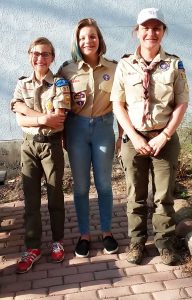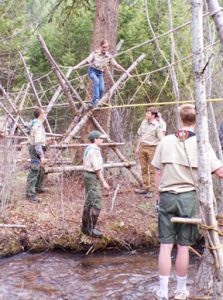
By Christin Rzasa
When the directors of the Boy Scouts of America (BSA) organization voted unanimously in 2017 to change the group’s name to Scouting BSA and allow girls to become members, two young Stevensville residents jumped at the chance. Meline Gardner and Ara Masar had tagged along with their older brothers on various outdoor Scouting adventures—with the kind indulgence of the boys’ Scoutmaster—and they’d not only loved the experience, the girls saw new opportunities for achievement that would carry them well into adulthood.
As Gardner puts it, “My older brother, Nolan, has always been in Scouting… and his Scoutmaster has always let me do most of the activities. Being along with my brother in Scouting made me [think], ‘Hmm, maybe I should join Scouting.’” Both girls had started out in Girl Scouts, but Gardner felt that the group experiences she was offered in Girl Scouts weren’t as active (especially in the out-of-doors) as what she saw her brother doing with his BSA troop. “I’m an active person,” she says, “so it wasn’t always easy for me to sit still. When I joined [the BSA], I felt like ‘this is what I’m meant to do instead of Girl Scouts.’”
Gardner’s friend, Ara Masar, relates a similar story. “My two older brothers are in her brother’s Scout troop, so we were all connected,” Masar explains. “Once they let girls into the program, my parents thought it would be easier…They’re already driving the two boys, and – like [Meline] said – you get to do more outdoor activities, so we get to go on more campouts.”
The Scouts BSA’s change from an all-male to a mixed-gender organization created some controversy, including backlash from the Girl Scouts organization, which claimed the move was an attempt to prop up membership numbers. In fact, club membership in general has declined in recent years among America’s youth. According to Chief Scout Executive Michael Surbaugh, Scouts BSA is expanding membership in an effort to bring “the values of Scouting to as many families and youth as possible” and to “help shape the next generation of leaders.” The change was initiated gradually, starting with the integration of Cub Scouts (children from kindergarten through fifth grade) in June of 2018.
Scott Jourdonnais, the Bitterroot and Mullan Trail Districts Executive for the Montana Council of BSA, explains, “Each Charter Organization (organization sponsoring each pack, troop, crew, etc.), and the current unit leader can decide what model [of integration] they would like to use. In both Mullan Trail and Bitterroot Districts, every Charter organization/pack opted to go with the boys/girls model in same pack with separate boy and girl dens (dens are the smallest grouping of the Cub Scouts).” A “pack,” which is a group made up of dens, can be co-ed. When students reach the age of eleven (or complete the fifth grade), both boys and girls can now become members of Scouts BSA. Gender-integration at this level of Scouts (where the sub-units are called “troops”) began in February of 2019. Packs and troops often gather to participate in mutual activities and have the chance to earn “merit badges” by learning new skills and completing a list of requirements. Earning badges allows Scouts to matriculate to the next level of Scouting, the highest of which is Eagle Scout. Gardner’s mother, Fabienne Wavrant, serves as the girls’ Scoutmaster. She explains that, “To reach the highest rank, Eagle Scout, they have 13 merit badges that they have to do, called the ‘Eagle-required merit badges.’ [They’re] all about citizenship, first aid, camping, cooking, finance management, personal fitness, communication…” In Gardner’s words, these badges represent “the essential things that you would need in life.”
Wavrant volunteered both as a Girl Scout troop leader for the girls (before they decided to change groups) and with her sons’ BSA groups. A native of France—where Scouting is co-ed—she has fond memories of her time as a Scout, and when her son, Nolan, was old enough, she thought it would be good for him to become involved with the BSA. Wavrant explains that parents who help with activities usually drop out as their Scouts graduate from high school, necessitating an ongoing quest for new leaders, so she became the leader of her son’s (Cub) den for a couple of years. When he moved up to the older Scout troop, she was asked to help with those activities as well. She now organizes the Scouts’ popcorn sales in the fall and acts as the Outdoor Coordinator where she’s in charge of “anything that has to do with outdoor activities.” Wavrant supported her daughter’s decision to switch groups and form the Valley’s first “female Troop BSA.”
“They [the boys in the other troops] have been really accepting of us,” she says. “The Scoutmaster for Nolan’s troop was really against [opening ranks to allow female members], but he knows Meline and he slowly warmed up to the idea. And now each time there is something that’s going on, he invites the [female] troop to join them. For instance, in March, we went to a campout that their troop was doing at the MPG Ranch. We only went for the day—they [the boys] camped the whole weekend—but it was all about primitive hunting techniques. So they threw some atlatls and learned to start a fire by friction…That was really hard work!”
Masar and Gardner are equally enthusiastic about the event. Although Gardner admits “I was only able to make smoke,” she adds that “it was one of the funnest things EVER!”
Wavrant and the girls have participated in more “camporees” (campouts with other troops) including a weekend this past spring on a ranch near Lolo, where they learned about ropes and knots and built a rope bridge over a creek. So far this year, the girls have earned their aviation merit badges (flying in a four-person airplane over their homes), learned about rock-climbing, and in March, they spent a weekend at Carroll College in Helena for a “Merit Badge University.”
“It’s actually a troop from Helena that organizes this every year in March,” Wavrant explains. “They get people from all different disciplines [as well as] people from Carroll College who help, acting as counselors by teaching the classes. The Scouts can earn as many as two merit badges in a day. I think there were as many as 600 Scouts participating.”
Masar said she and Gardner each ended up working on different merit badges, but it didn’t matter to the girls. “We stayed the night [on campus] and then the next day we did our merit badges…that was really fun. I like how the boys were really accepting to us being there…We were one of the only girl troops there, and we didn’t get any negativity from them.”
Currently, there are ten female BSA troops in Montana. When the girls and Wavrant decided to start a troop in the Bitterroot Valley, they discovered that their numbers were too small to meet Scout BSA requirements. By combining efforts with folks in the Missoula area, however, they were able to meet the population numbers necessary to form a troop. Wavrant hopes that—as they garner more members—the Bitterroot group can eventually split off on their own.
Both Gardner and Masar point to their enthusiasm for outdoor activities as the main factor in their decision to follow their brothers into Scouts BSA. Wavrant says the girls did go camping a couple of times as Girl Scouts “but it’s difficult because you need to have a certain number of adults to take the girls camping because of safety [concerns], and with such a little group [in Stevensville], it was difficult. …It just depends. Some Girl Scout troops are way stronger [more active in the out-of-doors] than others.”
Although their female BSA troop numbers currently stand at only four, the girls and Wavrant are optimistic about their future growth. Both Gardner and Masar hope to eventually attain the Eagle Scout level.
“We’re really trying to recruit more girls because it’s really fun,” Wavrant says. “And the Eagle Scout Award is really something that helps as the girls move to adulthood, for college applications and even for jobs.” She feels that the Girl Scout awards are not seen as the same level of achievement, unfortunately, even though they involve a similar amount of work.
“The Girl Scout awards don’t get the same recognition as the Eagle Scout designation. They should,” she insists, “because the work they put into it is kind of the same.”
Last year, when Gardner and Masar were still in Girl Scouts, Meline and Ara both earned their Bronze Awards. Wavrant explains, “They had to have a project [that includes] the whole community. They tried to put a ‘Non-smoking’ sign at Lewis and Clark Park. They went to the town council—to a couple of town meetings —they had an ordinance drawn up and then at the last minute, they [the council] said, ‘No.’” Wavrant talked with the Montana Girl Scouts Council and was able to convince them to give the girls the Bronze Award, because “the outcome was not their fault.”
If they had stayed in Girl Scouts and matriculated to the next level—Cadet—the girls would have had the opportunity to earn a Silver Award, which is similar to the Eagle Scout achievement, by creating a project where they must lead others in accomplishing something for the benefit of their community. The highest level of Girl Scouts (Ambassador) also carries a project requirement that is often not just locally but internationally focused. Wavrant feels that unfortunately, this award is “not recognized as the same level [of achievement] as an Eagle Scout project, and I think that’s why some of the girls want to join Scouts BSA—because of the recognition. I think that’s another reason why Meline and Ara chose to move to Scouts BSA.”

“The Girl Scout program is still a great program—it’s just different,” Wavrant says. “They have a different focus and it works for some people and Scouts BSA works for other people.” In Wavrant’s experience volunteering with the Stevensville Girl Scout group, she saw many of the participants’ interests change as they grew older, and they would move on to other activities. “Slowly we started losing some girls and it’s not as fun when you don’t have as many people.” Wavrant notes that there are BSA troops in almost every town in the Bitterroot Valley, but besides the Stevensville Girl Scouts, there is only one other Girl Scout troop, in Hamilton. Wavrant says that one is slowly getting smaller, as well. As the troop sizes diminish, so does the number of adults available to help with activities. By comparison, with the Scouts BSA troops in most Bitterroot Valley communities and the Mullan Trail troops from the Missoula area, there are always group functions in which the girls can participate.
Gardner and Masar—as well as Wavrant—are looking forward to a busy summer filled with Scouts BSA activities. In June, they’ll meet up with troops from across the state at Melita Island in Flathead Lake for the annual week-long gathering at the Scouts BSA camp. They’re also hoping to convince more girls to join in on their adventures, because—as Masar says—“If you like the outdoors, it’s REALLY GREAT for that!”
If you are interested in finding out more about Boy Scouts of America, go to montanabsa.org.